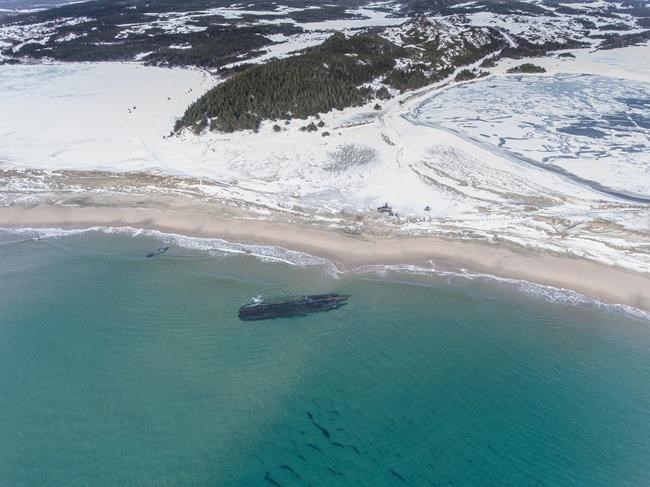ST. JOHN'S, N.L. — The massive, overturned hull of a seemingly ancient ship has appeared without warning along the southwestern tip of Newfoundland, dazzling nearby residents eager to know who may have been aboard and how it met its fate.
Wanda Blackmore says her 21-year-old son, Gordon, came roaring into her house on the morning of Jan. 20 after spotting the long shadow beneath the water just off the beach near Cape Ray, N.L. As soon as the tide went out, she put on her jacket and set out to see it herself.
Since then, the wreck has attracted a steady stream of local admirers heading out to examine its long, curved planks and the wooden dowels holding them together.
"It's amazing, there is no other word for it," Blackmore said in an interview. "I'm just curious if they can name the ship, and how old it is and if there were any souls lost on her."
Gordon Blackmore was out hunting seabirds early in the morning when he first saw the wreck, his mother said. He'd been at the same spot just a few days before and there was no sign of it.
But the beaches along that corner of Newfoundland have eroded substantially in the past few years. As post-tropical storm Fiona tore through the area on Sept. 24, 2022, destroying about 100 homes and pounding away shorelines, it churned up the sand along Cape Ray Beach, said Neil Burgess, president of the Shipwreck Preservation Society of Newfoundland and Labrador.
If the ship was buried, Fiona may have dislodged it from its sandy grave, and each subsequent storm would have loosened it further, Burgess said. There were large swells there last week, and they may have finally unearthed the wreck enough to be discovered by someone out hunting birds.
Burgess said he figures the ship was built in the 1800s, noting a few different factors led him to that conclusion. The wooden dowels noted by Wanda Blackwood are called trunnels and they were used as nails in wooden ships from that era. There are also copper pegs in the wreck, each more than two centimetres wide, which were used to fasten the hull's planks together, which Burgess said are quite large.
The emerged hull is about 24 metres long, and it's not complete, which means the ship itself was even longer than that, he added.
"It was a fairly substantial sailing ship, bigger than a schooner, I think," Burgess said, adding that if its hull is made of oak, it wasn't built in North America.
He hasn't yet been out to see the wreck — he lives in St. John's, about 900 kilometres east by highway — but he's looking for an opportunity to get there.
The seabed around Newfoundland is littered with "thousands" of shipwrecks and they surface from time to time, he said. But that doesn't make the Cape Ray wreck any less exciting.
"This is perfect," Burgess said. "This is a great, great event."
Wanda Blackmore is also excited, and she spent much of the past week emailing anyone she could think of — the Maritime History Archive at Memorial University, even the premier — who might be able to dispatch experts to Cape Ray and make sure the wreck is protected.
She hopes they'll be able to determine the ship's story and perhaps even get part of it displayed at the museum at the Cape Ray lighthouse, which is a federally recognized heritage structure. The first lighthouse at the site was built in 1871 to guide ships from all over the world through the Cabot Strait, at the meeting of the Gulf of St. Lawrence and the open Atlantic Ocean.
Cape Ray was part of a high-traffic route centuries ago, and the wreck could be from anywhere, she said. "We don't know!"
This report by The Canadian Press was first published Jan. 27, 2024.
Sarah Smellie, The Canadian Press



